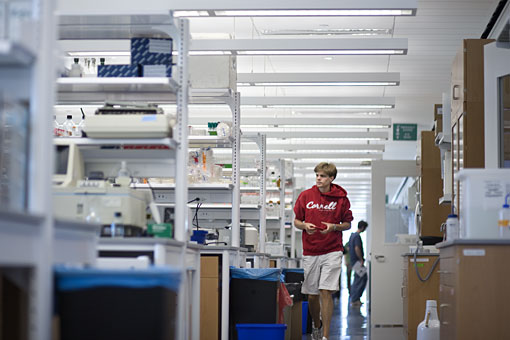COVER STORY
Structures of life: Ever more complex buildings are crucibles of ideas and innovation
(Page 3 of 5)Each research area in the building is divided into four distinct sections: One is for faculty and student offices; a second is a card-key-protected, windowless equipment corridor, complete with common-use centrifuges, freezers, mixers, cold rooms with shelves and counter space, and dark rooms for processing X-ray film for experiments with radioactive markers; the third, entered through 4-foot-wide doorways, holds support rooms that contain specialized instruments including microscopes, tissue culture facilities, mass spectrometers, and robots for protein crystallization assays; this leads to the fourth section, a surprisingly quiet area of open laboratory spaces where students, postdoctoral fellows and technicians are actively doing experiments at the bench.
Weill Institute associate director Tony Bretscher said he was initially concerned that the open labs would be noisy, but "in fact, they are quieter than the lab we were in previously," he said, pointing out that most of the loud, buzzing equipment is out in the middle corridor while the architect's use of noise-absorbing materials in the labs muffles other sounds.
Labs are also fitted with modular furniture and gas and electric outlets in the ceilings, so researchers can modify their space at any time. Fromme, for example, required constant temperature settings for growing protein crystals in a lab support room. The crystallized forms allow him to view a protein's atomic structure, which, in turn, offers clues to understanding a protein's function. But creating such crystals is trial and error, involving incubators and a robot that mixes chemicals around the clock. Solutions may sit for weeks, and temperature fluctuations can disrupt the crystals from forming. To set the room at a constant 68 degrees Fahrenheit, building manager Todd Pfeiffer reset the settings for the detectors that automatically control lights, air flow and temperature in the room to the new desired setting using the central building operations computer located in his office.

A view of one of Weill Hall's open lab areas.
Weill Institute
The Weill Institute lies at the very center of Cornell's New Life Sciences Initiative. Fittingly, the institute has the strongest presence in Weill Hall and fills the south wing on three floors.
The institute focuses on advancing the understanding of how a cell works, including such aspects as signaling, membrane trafficking -- how proteins are shuttled across cellular membranes (an area in which Emr is a world leader due to his use of a yeast cell model to study membrane trafficking, which applies to all cells) -- and how a cell is shaped and internally organized (which is Bretscher's area of expertise).
"The institute represents efforts to address fundamental problems in cell biology using the latest technologies and the most amenable model organisms," said Emr. "We're doing studies with flies, with worms, with yeast. The basic biology of a yeast cell is the same as the basic biology of a human cell."
The institute's directors and advisory committee are in the process of hiring a total of 10 faculty members. Three assistant professors (including Fromme) and one research scientist arrived in Ithaca in August. Emr and colleagues posted advertisements in the fall in prominent journals for two more hires.
"New buildings really help in recruitment efforts for new faculty," said Carlos Bustamante, professor of biological statistics and computational biology, who has an office in Weill Hall. "Many of the major universities we compete against to hire new faculty have taken similar initiatives in growth and development, so in order to attract the top people it really helps to have new, modern and beautiful facilities."
Emr noted "four key stimulants to recruiting": scientific interactions at the school, access to excellent students and postdocs, the laboratory space provided, and the funding and equipment made available to a candidate.